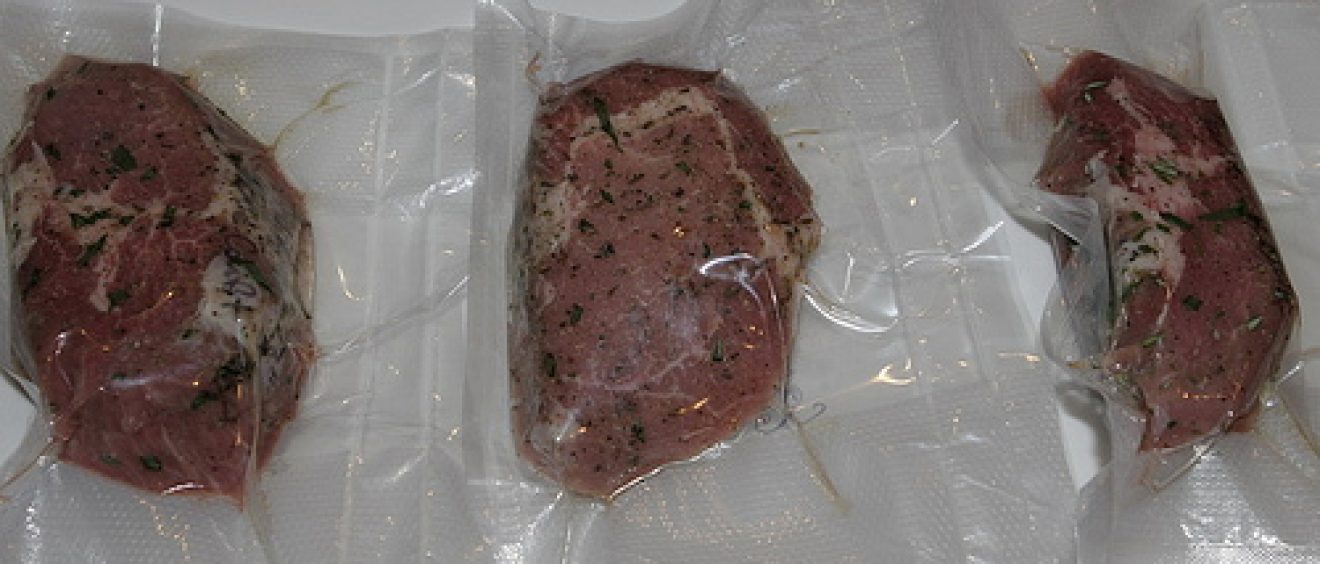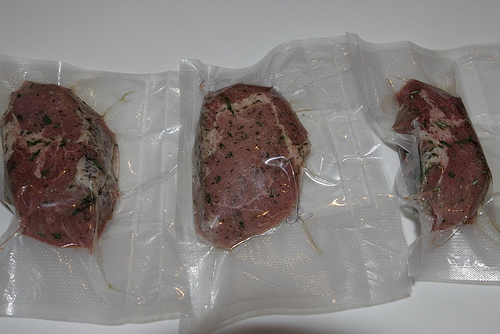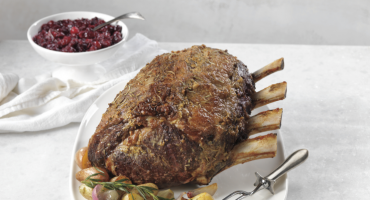
Sous Vide or Not Sous Vide?
We touched on this topic briefly during the final Top Chef live blog, but it’s such a dilemma for me that I really have to expand and get some serious input from the ES community.
First things first, I’m a total food sucker. OK that sounds really gross, but don’t worry, I chew my dinner like a regular person. What I mean is that even though a try to be an ultra-cynical food blogger, I have to admit I’m drawn in by pretty much every silly, over-hyped food world craze. Tell me grass-fed beef is trendy and I’ll switch to it. Mention that buffalo meat is the new pork? I’m game. Make bacon out of duck? Why not?
But inevitably, I’m never that impressed by these trends and get mad at myself for being sucked in. Grass-fed beef smells bad, buffalo is just kind of meh, and duck bacon is fine, but it’s no bacon-bacon. Yet of course I get suckered again and again. Which brings me to sous vide…
Ever since season three of Top Chef, when winning chef’testant Hung sous vide-ed over and over again, I’ve been fascinated by this mythical cooking method, which involves sealing food in airtight plastic bags and heating them in a water bath to a precise temperature. Apparently it turns water into wine, makes fruit taste better than steak, and transforms steak into…um, better steak.
So late last year, I was wishfully wandering through Williams-Sonoma and stumbled upon a display of Thomas Keller’s latest book, Under Pressure: Cooking Sous Vide. Obviously, the beautiful, oversized, overpriced thing went straight onto my Christmas list. While I’ve already spent hours pouring over the amazing photos in this book, it was perhaps not the best-thought-out gift request, since um, to cook sous vide you kind of need a $200 vacuum-sealer machine and a $1,000 sous vide machine. Brilliant move, BS.
Undeterred, I figured there has to be a half-assed way for me to cook sous vide. Just wrap the food in a ziplock and through it in a pot of boiling water, right? Apparently not. There are two main problems with faux-sous-vide cooking:
1) The whole point is you can cook food to a precise temperature (within one degree, even), and the sous vide machine circulates your water bath so that it’s always at the exact right temperature. Just throwing some saran wrap steak in a pot of warm water accompanied by a meat thermometer is not gonna achieve this.
2) If it’s not done properly, there’s a risk of botulism, a rather serious disease that results from toxins that grow on food in the absence of oxygen. Eek.
Wow, this is getting kind of serious. But browsing around the webs, I found there are more than a few botulism-flirts who have developed at-home ways to sous-vide your own food. My favorite is Grub Hacker, who made his own sous vide machine using a crock pot, mortar and pestle, and a fish tank pump. He’s since been busy making sous vide steak, duck, pork belly and the like.
There are also some infomercial-quality bootleg versions of sous vide equipment, like the rather sketchy looking SousVideMagic. They’re semi-affordable, but no one seems to have much good to say about them, and as JoeHoya said during the live blog: Buying a discount sous vide machine just screams “the guy who owns this effed up and got sick.”
So what the eff do I do? Help a cooker out. Your votes/comments would be greatly appreciated.
[poll id=”32″]
(Photos: smashz)





botulism isn’t all bad, BS, it prevents wrinkles in movie stars throughout the world!
Great blog! I think this falls into the food porn category of things that are fun to watch but that you should necessarily try at home…
oops I meant should NOT try at home. freudian.
How long before sous vide baths start showing up on wedding registries alongside breadmakers and creme brulee torches?
If you study up on the Sous Vide cooking process and safety then a properly built homemade system should operate much to the same temperature tolerances as a commercial model. Not to mention you can build a homemade model for a fraction of the cost. If you do your research properly and take the proper precautions most anything can be hacked up and created .
There is little difference in my system to the Sous Vide Magic other than timer feature and claimed higher precision in maintaining the water temperature. I have found that with my system I get around a 3 degree variance once everything is to temperature which I find to be very acceptable.
Great article and thanks for the shout out!
Seth
Grubhacker
Try before you buy. Consider going to restaurants that feature this technique, order a few selections, and determine if your palette registers a dramatic difference.
Sous vide cooking is no difference than roasting in a conventional oven. If you pick the wrong temperature and time, either method can make you sick. Sous vide cooking is not about low temperature cooking, it is about cooking at optimal temperature so each type of food can come out delicious, nutritious and safe to enjoy. I use Sous Vide Magic and find it very convenient and cost effective way to cook sous vide dishes with a cheap rice cooker. BTW I took my 80W rice warmer/sousvidemagic and plugged into (via a DC/AC inverter) in my car for a family picnic last summer. Next time I will remember to use it for a wedding in a tent too, Thanks JoeHoya.
Kmango, a good sous vide dish is one you don’t know it is being sousvided; It just makes conventional dishes better, that’s all!!
don’t be a sucker. and just regift that book
I just can’t imagine how shrink-wrapping food in plastic can add to its flavor.
I can’t imagine why anyone would say something negative about the SousVideMagic. Once calibrated (use a basal thermometer to get .01F accuracy at 100F), it is quite accurate and repeatable. I cook brisket at 135F for 48 hours in a 10-liter rice cooker, and the result is melt-in-your-mouth tender, with a very robust flavor, and yet still medium rare. No other combination of heat, braising, simmering, etc., can provide that effect.
Once the final temperature was reached (maybe 30 minutes after turning it on with the meat in it), it never varied so much as 0.1F during that time. Yes, you could make your own, if you are a competent engineer and understand PID controllers, but for $139 why bother? Don’t you have better things to do with your talent?
Temperature is temperature, and if it works, it works, and you certainly don’t need a $1500 laboratory immersion circulator for this purpose. If you feel some Freudian need to swirl water around, a $15 submersible garden fountain pump will do just fine, or an aquarium air bubbler, but a rice cooker does perfectly well by natural convection, because of the bottom heating.
To get started, use a $20 home rice cooker (without fuzzy logic), or use your existing CrockPot, roaster, deep fat fryer, or even a diaper pail with an electric hot plate, and give it a try. Once you do, you’ll be hooked, I promise you.
See Douglas Baldwin’s A Practical Guide to Sous Vide Cooking (http://amath.colorado.edu/~baldwind/sous-vide.html) for time-temperature tables for safe cooking and storing techniques for all sorts of meats and fish to avoid botulism and other nasties.
I believe the food safety nannies’ message is tuned to protect the lowest common denominator (you know… morons.) The sorts of people who try to cut their hedges with their lawnmower, burn their houses down while deep frying a turkey, etc.
Poor food hygiene practices are bad no matter what the cooking technique. You might think you are protecting yourself with that well done steak, but what if you sat it on a unclean cutting board to rest after it came out of the pan? or used the same unwashed utensils that were used to prepare it?
Sous vide poses no significant new challenges, but it’s unfamiliar which prompts the chicken-little response in the science-illiterate types.
I’ve been experimenting with the technique for a few months now. I started with a big stew pot on my stove, a thermometer, and ziplock bags. With a watchful eye you can maintain pretty good temperature control in a purely manual manner… although for practical purposes, you would want to stick to preparing things that require shorter cooking times and not ultra-precise temperature control. The biggest pain will be the bags… Most garden-variety ziplock bags aren’t up to the task of remaining water tight. You’ll cry when you get ready to eat, only to discover you’ve accidentally poached your sirloin steak. I’ve had good luck with the really thick plastic freezer bags. To get the air out, carefully squeeze it out and seal it, or almost completely submerge it in water (which will force out the air) and seal it. That should be good enough. The main reason you want the air out is to keep the package from floating… (which becomes more likely the hotter the sous vide temperature.) A vacuum sealer is obviously the way to go.
For temp control… the sous-vide magic device is hard to beat. But if you like finding excuses to build stuff like I do… it’s quite easy to beat the price and match the performance DIY. I used a PID controller module and a solid state relay, both sourced from ebay, for ~ $50. Less than 20min to wire them up, and presto: you’re in business.
Use it to control a hot plate, rice cooker, whatever…
I’ve been delighted with the results. I now have perfect control over doneness… and can turn flavorful but tough cuts tender.
Where this really comes into it’s own is if you have a deep freezer… Buy a side of beef, have it butchered into individual portions, vacuum bag & freeze. Go straight from freezer to sous vide bath. Freaking brilliant. It’s really nice when you have a party, people showing up at odd times… you can have everything staged and ready to go in the bath, pulling them out on demand. It’s no wonder why commercial kitchens have taken to this. Less waste, more consistency, better results. What’s not to love?
We bought the Sous Vide Magic last year and have had no problems with it at all. It isn’t rocket science how these things work and, as Mark says, the parts are readily available. It is useful for things other than just sous vide and it is always nice to have something in the kitchen that isn’t single task. We have used the controller for making cheese as well as for sous vide and it functions just as it is suppose to. I’m not sure on your background BS, but this doesn’t look “infomercial quality bootlegged” or “sketchy” to me. I’m with Robert on the fact that my time is worth something and I just don’t feel like spending the time putting something like this together when it would only save me less than $70.
Having worked in electronics most of my life, and Barbara being a physician, it appears to us that for this purpose you just don’t need lab grade equipment. Any time you get something that is labeled “lab” or “medical” grade you pay out the kazoo.
Since this is just one of many tools in our kitchen we treat it as such. We still check temperatures with a secondary thermometer, we still use our own judgment, and we carefully consult the available information on food safety and this method of cooking. If you don’t follow normal precautions any cooking method can make you sick.
Of course if you like spending lots of money on packaging have at it. The American economy has always depended upon people that like hype and pretty packages!
Toby and Barbara
@Colleen “I just can’t imagine how shrink-wrapping food in plastic can add to its flavor.”
It doesn’t. Just like putting a stainless steel lid on a steamer doen’t add to the flavor. Don’t build straw men – think.
I just took a cooking class last night on Sous Vide. I had never had it before and was curious about this tye of cooking. My husband and I are learning to eat healthier and I was intrigued by Sous Vide because of no added fat and the ability to retain more nutrients. I was blown away with the wonderful textures and flavors that the instructor was able to get out of beef, chicken and fish. Then we were shown how to cook eggs, vegetables and even make desserts. My husband is very picky about what he eats and he loved everything. Whoever says they do not know how food can be better cooked in a bag has not had Sous Vide. I am a believer and now need to figure out how to do it without a $500 machine.
Hi,
I picked up a Sousvidemagic, it is damn good, converts a rice cooker in to a precision water bath. Have cooked duck, beef, chicken and eggs all to perfection.